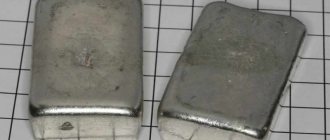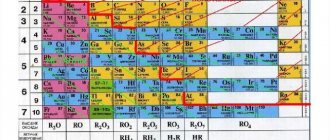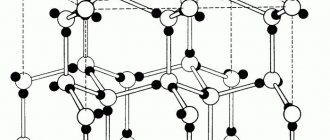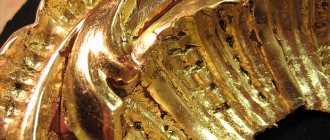Rare metals are a conventional group of 60 chemical elements. They have similar properties and characteristics and are rarely found in nature. The development of deposits of rare metals is a promising direction. Representatives of this group have not yet been fully studied, which makes them valuable for use in industry and research by scientists.
Rare metals
California 252
At the moment, there is no metal in the world that would cost more than California 252. Its unusually high value is registered in the Guinness Book of Records and is equal to 10 million dollars per 1 g.
Every year, through complex and painstaking work, 35–40 mcg of the element is obtained. Its worldwide supply is only 8 g.
Californium 252 does not occur in nature; it was synthesized by American scientists in 1950. Currently, the unique metal is produced at the Dimitrovgrad RIAR and the Oak Ridge National Laboratory in the USA.
The metal is valued for its unprecedented energy, comparable in power to the energy of an average nuclear reactor. They are used in nuclear physics and in medicine in the treatment of cancer. With its help, new deposits of gold and silver are found and defects in aircraft reactors are identified.
Extraction methods
Open
Since significant reserves of rare metals are concentrated in the earth’s crust, subject to weathering and placers, the most common method of their extraction is the open-pit method. To develop placer deposits, a dredge is often used - a floating mining and processing complex.
In the case of quarry deposits, a complex of geological exploration, stripping, excavation and transport work is carried out, followed by enrichment. Naturally, this is associated with high costs and harmful effects on the environment.
Closed
The mine mining method does not lose its position in the list of methods for extracting such minerals as rare metal ores. It is usually used when there is a need to remove expensive rocks from the bowels of the earth, located at depths of up to half a kilometer or more.
Otherwise, production will be unprofitable, since it will not cover the costs of constructing a mine and operating expensive equipment.
Rhodium
The rarest precious metal was first obtained in the USSR in 1925. To produce 1 kg of rhodium, about 10 tons of platinum are needed.
Rhodium has powerful reflective properties and high resistance to corrosion and oxidation.
It is used in many areas: in the glass industry, in mechanical engineering, for the final coating of jewelry (gives them shine and prevents darkening), for the production of nitric acid.
The annual world production of rhodium is about 30 tons. Russia, Canada and South Africa can boast of significant deposits. Cost: $170 for 1 g.
Enrichment technology
The raw materials from which rare metals and elements are extracted usually contain tenths or even thousandths of a percent of the necessary materials.
Preparatory process
Crushing and grinding separate mined minerals from waste rock. The result is a product in a form acceptable for further processing with a given concentration of the mined metal.
In case of difficulties with enrichment (uranium ores or a number of other minerals), hydrometallurgical methods for extracting metals are used. For a number of valuable large-size fraction minerals, manual mining of ore on a conveyor is used.
Main process
The main beneficiation process consists of mechanical, physical and chemical processes, the purpose of which is to obtain concentrate (a product of ore enrichment that has a high concentration of the required mineral) and waste.
In the case of processing rare metal ores, the following types of enrichment are used:
- Crushing followed by screening is based on the different degrees of hardness of useful and waste rocks.
- Sliding of the necessary minerals along an inclined plane at a speed different from unused materials.
- Gravity enrichment - the operating principle of this method is based on different speeds of falling mineral grains in a gaseous or liquid medium.
- Flotation enrichment, which is based on a change in surface wettability under the influence of flotation reagents.
- Magnetic enrichment separates materials based on their magnetic properties.
- Electrostatic beneficiation is based on the use of differences in the electrical properties of minerals.
Helper process
Technological processes that facilitate the main processing processes are called “auxiliary”.
It is not possible to obtain rare metals directly from ores. The output of a number of complex basic processing processes are only oxides and salts. Naturally, end consumers are not satisfied with this, since they require highly purified metals.
To solve this problem, enrichment methods are used, the essence of which is: decomposition, creating compounds of the required purity, obtaining technically pure metal or alloys with its presence in their composition, refining the metal, obtaining ingots or products with the simultaneous formation of the desired physical and chemical structure. These methods are based on hydrometallurgical, chemical and pyrometallurgical processes.
Gold
Plasticity, strength, uniformity and durability have made the precious metal one of the most sought after on the planet. It is considered a highly efficient heat conductor and is valued for its lack of reaction to acids and other chemical elements.
Gold can maintain perfect condition for hundreds of years. In nature it exists only in its pure form.
Used in medicine and cosmetology, dentistry, jewelry, electrical industry and instrument making. Used for investing and lending.
The leading positions in gold mining are occupied by the USA, China and Australia. Cost: $65 for 1 g.
Saffron - $11 per gram
Saffron is not even close to being one of the rarest elements on Earth; however, it is featured on our list. The reason is that it grows in the middle of a crocus flower, which is an extremely labor-intensive crop. About one acre of purple crocus yields only one pound of saffron.
Saffron is widely used in Indian, European and Turkish cuisines. There is some evidence that saffron helps with depressive disorders. It may also help relieve symptoms of premenstrual syndrome.
Platinum
Platinum was discovered in Colombian mines in the 16th century by Spanish conquistadors. The unknown metal, which resembled silver, was at first considered absolutely useless and was contemptuously called “silver.”
It was often used to counterfeit gold and silver items. Over time, platinum gained popularity.
This is one of the rarest elements found in alloy with other metals. About 150 tons of platinum are mined annually in the world. The synthesis process is labor-intensive and expensive, which determines the price level.
Refractory and fireproof, platinum has high density and excellent wear resistance. It has low thermal conductivity and does not deform. Almost unaffected by any acids. Plastic, naturally white and shiny.
It is used in the automotive industry, radio engineering, computer production, the space industry, medicine, weapons and jewelry.
Russia, the USA, China, South Africa, and Zimbabwe are famous for deposits of this metal. Cost: $33 for 1 g.
Science for life: top 7 most valuable and expensive metals on earth
In the modern periodic table, out of 118 chemical substances, more than 90 are various metals. We talk about the most expensive metals on Earth, where they are used and mined.
Some metals are common, there are no special problems with their extraction and they are inexpensive, such as the most common one, aluminum. But there are also rare metals, incl. those that are obtained exclusively in laboratory conditions. The price per gram of such metals can reach millions of dollars, writes nauka.boltai.com.
Indium
This is a rather rare, but not too expensive metal. It was discovered in 1863 and is a component of the ore of zinc, lead, copper and tin. In its pure form, it is a white and very shiny metal that can be easily melted and cut with a regular knife. The largest suppliers of indium are China, South Korea and Japan: they annually produce several hundred tons of metal.
Indium is actively used in electronic equipment and cars. During World War II, this metal was used in bearings for aircraft engines.
Silver
Silver has been known to mankind since ancient times. In nature, it is found both in pure form and as a compound in ores of other metals. Silver is a highly ductile metal with a silvery-white color. The largest producers: China, Canada and the USA - they produce about 22 tons of metal every year.
Despite its high cost, silver is used in many industries. It is used to make jewelry and coins, and is used in electronics and dentistry. It is believed that silver prevents the spread of bacteria, and the metal itself is safe. There is always a high demand for it, hence the rather high price.
Iridium
The metal iridium was discovered in 1803 and is mainly mined from platinum ores. It is white in color and has a very high melting point - 2466 degrees Celsius. It is not afraid of corrosion and even acids - it is the most resistant metal. South Africa is considered the largest supplier of iridium: it produces about a ton of metal per year.
Iridium is not used in its pure form; most often it is added to platinum. The alloy of iridium and platinum is excellent for making jewelry - they look beautiful and practically do not wear out. Iridium is also in demand in the manufacture of surgical instruments, aerospace equipment and electronics. The nibs of expensive writing pens are also made from this metal.
Palladium
Opened in 1803. Palladium is a very rare silver-white metal that melts easily and does not tarnish or rust. It is extremely rare in nature; it is mainly mined from nickel, silver and copper ores. The largest supplier is South Africa, and small quantities are also mined in Russia.
Palladium is actively used in jewelry; when mixed with gold, one can obtain the so-called “white gold.” Rare coins dedicated to memorable historical dates are minted from it. The metal is also in demand in medicine: parts for pacemakers and dentures are made from it.
Platinum
Many peoples did not know about the existence of platinum until the 16th century, but there are those who have used this metal since time immemorial. Platinum is found only as an alloy with other metals, but in its pure form it is a silvery-white metal. It became popular due to its beautiful appearance and plasticity. The largest suppliers are South Africa, Russia, the USA and Canada.
Platinum is used in the jewelry industry, in technology, and coins are minted from it. Mirrors for laser technology are made from it. The demand for platinum is high, so it is very expensive.
Gold
Man learned about gold as early as 9500 BC. Today its extraction requires a lot of time and effort, but previously this metal was found in the form of ingots. It has high strength and is very flexible. The largest suppliers of gold were China, Australia, Russia and the USA. For centuries, gold has been considered the most coveted precious metal.
Many jewelry items are made from gold. Due to the fact that gold is an excellent conductor of electricity, it is actively used in the production of electronics. It is also in great demand in dentistry.
Californium
Scientists first obtained it in 1950. It is the most expensive metal because only 20–40 micrograms of californium are produced each year. The total global supply is only 8 grams. To create californium, nuclear reactors are used, which are located in the United States and Russia. The main value of californium is that a gram of this element produces the energy of an average nuclear reactor.
Californium is used in medicine to treat malignant tumors - sometimes other radiation therapy is useless. The metal is also used in scientific research and in diagnosing aircraft damage.
Photos from open Internet sources
Osmium 187
To produce a unique synthesized black powder with a purple tint, which is a complex isotope, it takes about 280 days. Its creation poses a number of certain difficulties.
Osmium 187 is the densest substance on Earth, the strongest and at the same time fragile metal in the world.
It is of enormous importance for scientific research and is used as a catalyst in chemical reactions. Used for the production of high-precision measuring instruments.
The first and only country providing this valuable element to the world market is Kazakhstan. Cost: $200,000 per 1 g.
History of discovery
Rare metals are a relatively new term that refers to little-studied chemical elements. This designation first appeared in the 20s of the last century. Abroad, the first term to appear was Less Common Metals. If we translate it literally - less ordinary metals.
A sharp increase in mining and production of rare metal elements was recorded after the end of the Second World War. Then it was necessary to restore the main areas of industry. New chemical elements made it possible to create innovative materials and develop new technologies at an accelerated pace.
Metal mining (Photo: Instagram / metinvest)
Palladium
The silvery-white isotope, a member of the noble platinum metals, was discovered by British chemist William Wollaston in 1803. The main advantages of palladium are ductility, softness, low melting point, resistance to darkening and corrosion.
Palladium is widely used in industry and the medical field. Indispensable in the manufacture of jewelry: thanks to its lightness, you can create real masterpieces of art from it.
The largest deposits were found in Russia (Murmansk, Norilsk, Talnakh), Africa, Canada, Alaska, Colombia, and Australia. Cost: $90 for 1 g.
Rare earth reserves
The total amount by mass of rare earth metals in nature is no more than 0.02%. Most often, cerium, lanthanum and neodymium are found in the bowels of the Earth. The least common compound is Europium. Its percentage in the bowels of the Earth is no more than 0.0013% of its total mass.
Worldwide, rare earth metals are found in 240 mineral substances: fluorides, silicates and phosphates. 62 minerals are used as industrial raw materials: monazite, apatite, bastnäsite and euxenite. The percentage of REE in the composition of mineral substances is not the same. Bastnaesites contain predominantly representatives of the cerium subgroup, while apatites contain predominantly representatives of the yttrium subgroup.
Rare earth elements occur together in the natural environment, forming sulfides or halogen compounds. The valence of substances is no more than 3+. In nature, cerium can form tetravalent compounds, which is due to the structural features of its electronic shell.
The main reserves of rare earth metals are contained in the following countries:
- USA: 13,000,000 tons;
- Australia: 1600000 t;
- Brazil: 36,000 tons;
- China: 55,000,000 tons;
- India: 3,100,000 tons;
- Malaysia: 30,000 tons.
In Russia, 90% of rare earth elements are imported from other countries. This is due to the fact that there is low demand for these compounds on the Russian market. Due to the development of scientific and technological progress, the largest amount of rare earth resources is consumed by developed countries in Europe and North America.
Scandium
High-strength scandium was predicted by D.I. Mendeleev in his article in 1870 (as ecaboron), and discovered in 1879 and named in honor of Scandinavia by the Swedish chemist professor Lars Nilsson.
The silvery-yellow element is incredibly dispersed: its content in minerals can reach 10 g per ton. Metal mining is extremely expensive.
Thortveitite is the richest in scandium. Its significant deposits are concentrated in Norway and Madagascar. From 1911 to 1952, only 23 kg of torveitite was mined in Norwegian mines.
Scandium has a rare combination of high heat resistance and lightness. It is used in robotics, the creation of laser technology, the space industry, and the sports field (high-quality equipment for cycling, hockey and golf is made from scandium). Cost: 4 $ for 1 g.
Painite – $8,500 per gram
Painite is a very rare borate mineral found in Myanmar. It contains trace amounts of vanadium and chromium and is orange-red or brownish-red in color.
As of 2004, there were fewer than 25 known crystals, although many more materials have recently been discovered in Myanmar. Only a few of them are privately owned. The remaining stones are distributed between the Gemological Institute of America and the GRS Gem Research Laboratory and the British Museum of Natural History.
Applications of rare earth metals
Rare earth metals have found application in the following areas:
- Production of hard drives and audio speakers.
- Manufacturing of cameras, telescopic lenses, projectors, studio lighting fixtures and batteries.
- Crude oil refining.
- Development of reinforced metals and glasses used in aircraft engines and protective masks for construction workers.
- Creation of liquid crystal displays, MRI machines, X-ray systems, energy-saving lamps and nuclear reactors.
REE are also used to make additives and enamels necessary for modifying materials. They improve the ductility and strength of raw materials, which increases the service life of various apparatus and metal devices. Due to the increased absorption rate of carbon and nitrogen oxides, REMs can be used in hydrogen thyratrons as an insulating material.
The use of rare earth elements has a negative impact on the ecology of the planet. As a result of the mining and production of rare earth elements, large amounts of harmful substances and toxins are released into the atmosphere, including carbon. Currently, technology is being developed to determine the toxicity of rare earth metals using biotesting. Scientists are creating biosensors that determine the effect of metals on the human body using special biosensors. In the manufacture of test devices, environmentally friendly materials are used: Paramecium Bursaria and Chlorella algae.
Silver / Ag (~ 0.5 USD per 1 gram)
Our top 10 opens with silver, called argentum in Latin. Silver has been known to mankind since ancient times because it can be found in nature in the form of nuggets, and it does not require any chemical processes to obtain. The metallic color itself is named after Argentum - silver.
Silver is a noble metal with a melting point of 962 degrees Celsius. It has the highest thermal conductivity of all known metals. It is widely used in the production of electrical engineering and electrical equipment, jewelry, and is included in the composition of various high-tech alloys used in a wide variety of areas of human activity.
Silver has long been known for its antibacterial properties; it can be used to destroy about 700 types of different bacteria.
Even on space stations, all water is purified with silver, and some housewives throw silver coins into milk to extend its shelf life.










